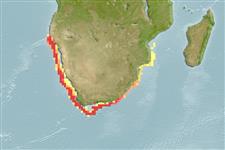>
Gadiformes (Cods) >
Merlucciidae (Merluccid hakes)
Etymology: Merluccius: Latin, mar, maris = the sea + Latin, lucius = pike (Ref. 45335).
Environment: milieu / climate zone / depth range / distribution range
Ecologie
marien bathydemersaal; standvastig; diepte 200 - 1000 m (Ref. 6605), usually 400 - ? m (Ref. 58452). Deep-water; 17°S - 38°S, 10°E - 48°E (Ref. 58452)
Southeast Atlantic: Cape Frio, Namibia south to the Agulhas Bank and east to East London in South Africa. Western Indian Ocean: Madagascar Ridge (33°S,44°E).
Lengte bij maturiteit / Grootte / Gewicht / Leeftijd
Maturity: Lm 47.8 range ? - ? cm
Max length : 115 cm TL mannelijk / geslacht onbekend; (Ref. 27121); common length : 60.0 cm SL mannelijk / geslacht onbekend; (Ref. 1371)
Korte beschrijving
Morfologie | Morfometrie
Dorsale stekels (totaal): 1; Dorsale zachte stralen (totaal): 42-50; Anale stekels 0; Anale zachte stralen: 38 - 41. Body more slender than other hakes. Head large, about 25 to 30% of SL. Gill rakers short and thick with blunt tips. Pectoral fin tips reaching to level of anal fin origin. Color is steel gray on back, grading to silvery white ventrally.
Found near the bottom. Feeds on fishes, mysids, euphausiids and squids. Young feed mainly on euphausiids, but the diet becomes polyphagous with growth. Cannibalism has been observed in larger individuals (Ref. 9583).
Levenscyclus en paargedrag
Maturiteit | Voortplanting | Paaien | Eieren | Fecunditeit | Larven
Cohen, D.M., T. Inada, T. Iwamoto and N. Scialabba, 1990. FAO species catalogue. Vol. 10. Gadiform fishes of the world (Order Gadiformes). An annotated and illustrated catalogue of cods, hakes, grenadiers and other gadiform fishes known to date. FAO Fish. Synop. 125(10). Rome: FAO. 442 p. (Ref. 1371)
Status op de Rode Lijst van het IUCN (Ref. 130435)
Gevaar voor de mens
Harmless
Gebruik door de mens
Visserij: van groot commercieel belang
Tools
Speciale rapporten
Download XML
Internetbronnen
Estimates based on models
Preferred temperature (Ref.
123201): 6.2 - 12, mean 7.5 °C (based on 17 cells).
Fylogenetische diversiteitsindex (Ref.
82804): PD
50 = 0.5000 [Uniqueness, from 0.5 = low to 2.0 = high].
Bayesian length-weight: a=0.00525 (0.00348 - 0.00791), b=3.09 (2.96 - 3.22), in cm total length, based on LWR estimates for this species & Genus-body shape (Ref.
93245).
Trofisch niveau (Ref.
69278): 4.9 ±0.2 se; based on diet studies.
Weerstandsvermogen (Ref.
120179): laag, minimale populatieverdubbelingstijd 4,5-14 jaar (K=0.09-0.12).
Fishing Vulnerability (Ref.
59153): High to very high vulnerability (65 of 100).
Climate Vulnerability (Ref.
125649): High vulnerability (55 of 100).
Nutrients (Ref.
124155): Calcium = 7.36 [3.59, 25.05] mg/100g; Iron = 0.274 [0.058, 0.735] mg/100g; Protein = 17.3 [16.1, 18.5] %; Omega3 = 0.146 [0.078, 0.273] g/100g; Selenium = 28 [13, 66] μg/100g; VitaminA = 11.7 [2.4, 55.4] μg/100g; Zinc = 0.186 [0.127, 0.288] mg/100g (wet weight);
